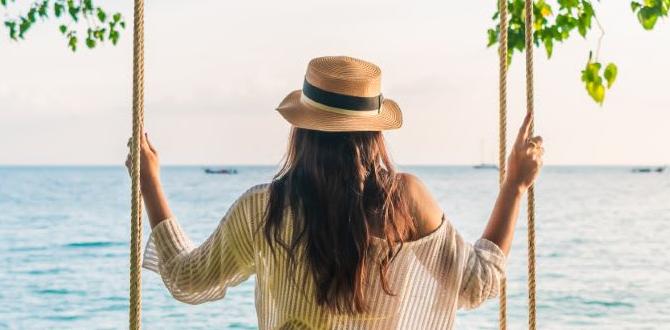Understanding Agra’s local etiquette and tipping customs shows respect and enhances your travel experience. This guide provides clear, simple advice on greetings, dress code, dining, and appropriate tipping amounts for various services, ensuring you navigate social situations with comfort and confidence.
Welcome to Agra, home of the magnificent Taj Mahal! As you plan your visit to this incredible city, you might be wondering about the local customs – how to greet people, what to wear, and especially, how to handle tipping. It’s completely normal to feel a little unsure!
Traveling should be exciting, not stressful, and knowing a few key things about local etiquette and tipping can make your journey much smoother. We’ll walk through everything you need to know, step by step, so you can explore with ease. Get ready to feel confident and prepared for your amazing Agra adventure!
Understanding Agra’s Social Landscape
Agra is a city steeped in history and culture, and like any place, it has its own unique social norms. These aren’t strict rules meant to trip you up, but rather gentle guidelines that help foster mutual respect and understanding between visitors and locals. By being aware of these customs, you show genuine appreciation for the culture you’re experiencing, which often leads to warmer interactions and a more authentic visit. Think of it as learning a few key phrases in a new language – it opens doors and makes connections easier.
The primary goal of understanding local etiquette is to ensure you feel comfortable and confident in every situation, whether you’re visiting a bustling market or enjoying a quiet meal. It’s about navigating your journey with grace and thoughtfulness. This guide is designed to be your friendly companion, breaking down essential aspects of Agra’s social fabric into easy-to-digest tips.
Greetings and Introductions
How you greet someone can set the tone for your entire interaction. In Agra, like much of India, traditional greetings are warm and respectful.
The Traditional ‘Namaste’
The most common and widely accepted greeting is ‘Namaste’ (pronounced nah-mas-tay). To perform it, bring your palms together in front of your chest, fingers pointing upwards, and give a slight bow of the head. This gesture conveys respect and a sense of peace. You can say ‘Namaste’ when meeting new people, entering someone’s home, or as a general greeting to shopkeepers and hotel staff.
Handshakes
While ‘Namaste’ is the traditional greeting, handshakes are also common in more business-oriented or informal settings, especially among men. However, it’s best to wait for a local to initiate a handshake, particularly if you are a woman greeting a man. Indian women may prefer not to shake hands with men they don’t know well, so observing the other person’s lead is always a good idea.
Addressing People
Using appropriate titles shows respect. For elder men, adding ‘ji’ to their name (e.g., Mr. Sharmaji) or using terms like ‘Sir’ or ‘Uncle’ is common. For elder women, ‘ji’ can also be used, or terms like ‘Ma’am’ or ‘Auntie’. When in doubt, a polite address is always appreciated.
Dress Code and Modesty
Dressing considerately is a key aspect of showing respect for local customs in Agra. India, in general, is a conservative society, and Agra, being a culturally significant city, particularly values modesty.
General Guidelines for All Visitors
- Cover your shoulders and knees: This applies to both men and women. Avoid revealing clothing like tank tops, short shorts, or miniskirts when visiting religious sites or general public areas.
- Opt for loose-fitting clothing: Think breathable fabrics like cotton, which are comfortable in Agra’s climate and also more modest.
- Scarves and Dupattas: A lightweight scarf or dupatta is a very versatile accessory for women. It can be used to cover your head when entering a temple or mosque, or simply to add an extra layer of modesty when needed.
Specifics for Women
While Western attire is increasingly common in tourist areas, opting for more traditional Indian clothing like kurtis (tunics) with leggings or loose trousers, or even a modest salwar kameez, can make you feel more comfortable and blend in with the local population. If you choose to wear Western clothing, opt for longer tops, capris, or knee-length skirts and dresses.
Specifics for Men
Long trousers or comfortable cotton pants are recommended over shorts. T-shirts or collared shirts are generally acceptable. Again, avoiding overly tight or revealing clothing is advisable.
Temple and Mosque Etiquette
- Remove shoes: You must remove your shoes before entering any place of worship. Look for designated shoe-minding stalls, often for a small fee, or leave them at the entrance.
- Cover head: Some mosques and temples may require you to cover your head. Women might need to cover their heads entirely, and men might need to wear a cap in some Islamic sites.
- Respectful behavior: Avoid loud talking, intrusive photography, or any behavior that could be seen as disrespectful to the sanctity of the place.
Dining and Table Manners
Sharing a meal is a wonderful way to experience local culture. Understanding basic dining etiquette will enhance your experience and ensure you’re comfortable.
Eating with Your Hands
In many traditional Indian settings, especially when eating thalis (a platter of various dishes) or certain types of curries and rice, it’s common to eat with your right hand. The left hand is traditionally considered unclean, so always use your right hand for eating and offering/receiving food or items.
- Use your fingertips: Gently mix rice or curry with your fingertips and bring it to your mouth.
- Wash your hands: Always wash your hands thoroughly before eating. Most restaurants will provide water and basins for this.
Using Cutlery
Don’t worry if eating with your hands isn’t for you! Most restaurants in Agra catering to tourists will provide cutlery. It’s perfectly acceptable to use a fork and spoon if you prefer.
Accepting Food and Drink
It’s considered polite to accept offered food or drink, especially when hosted by locals. If you have dietary restrictions, it’s best to state them clearly and politely beforehand. Refusing food outright can sometimes be seen as impolite.
Tipping at Restaurants
Tipping practices in India are a bit different from what you might be used to. Service charges are often already included in the bill at tourist-oriented restaurants.
- Service Charge: Many bills will have a ‘service charge’ listed. This is essentially a tip that is distributed among the staff. If this is included, an additional tip is often not expected, though it’s always appreciated for exceptional service.
- Optional Additional Tip: For excellent service at mid-range to high-end restaurants, an additional tip of 5-10% of the bill after the service charge (if applicable) is a nice gesture. For casual eateries, rounding up the bill or leaving a small amount for good attention is sufficient.
- Street Food: Tipping is generally not expected for street food vendors.
Quick Tip: Always check your bill for a service charge before deciding on an additional tip. If unsure, ask the staff politely.
Tipping Guide: Who, When, and How Much?
Tipping can feel like a minefield when traveling to a new country. In Agra, it’s a way to acknowledge good service, but it’s important to have a general understanding of expectations so you don’t over or under-tip. Remember, a tip is generally for services rendered, and in India, it’s often a welcome bonus rather than a mandatory practice in many cases.
Hotels
The rules for tipping in hotels can vary depending on the level of service and your personal experience.
- Porters/Bellhops: For carrying your luggage to your room, a tip of ₹50-₹100 per bag is customary.
- Housekeeping: If you wish to tip the housekeeping staff for keeping your room clean, you can leave ₹100-₹200 per day discreetly in the room (e.g., on the pillow or bedside table) at the end of your stay.
- Concierge: If the concierge provides significant assistance (e.g., booking tours, making difficult reservations), a tip of ₹100-₹300, or more for exceptional service, is appropriate.
- Room Service: If a service charge isn’t included, a tip of 5-10% is customary for room service.
Tours and Guides
Your guide can significantly enhance your understanding and enjoyment of Agra’s sights.
- Tour Guide: For a full day of guiding (especially at historical sites like the Taj Mahal and Agra Fort), a tip of ₹500-₹1500 per day is a good range, depending on the guide’s expertise, language skills, and the quality of service. Some guides manage to get you special access or provide in-depth historical context, which warrants a higher tip.
- Drivers: If you hire a private car and driver for the day or for a specific excursion, tipping them ₹300-₹800 per day is a common practice. This can increase if they go significantly out of their way for you or prove to be exceptionally helpful.
Transportation
Getting around Agra often involves local taxis, auto-rickshaws, and ride-sharing apps.
- Auto-Rickshaws/Tuk-Tuks: For short rides, it’s common to simply round up the fare to the nearest ₹20 or ₹50. If the driver was particularly helpful or you negotiated a fare higher than the meter, a small extra tip isn’t necessary but is appreciated. Always agree on the fare before starting the journey if the meter isn’t used.
- Taxis: For pre-paid taxis or metered taxis on longer journeys, tipping around 5-10% of the fare is a good practice.
- Ride-Sharing Apps (Uber/Ola): While you can tip directly through the app, many drivers appreciate a small cash tip for good service, especially in Agra. The tipping guidelines for taxis generally apply here as well.
Other Services
Beyond hotels and meals, there are other services where tipping might be appropriate.
- Spa/Massage Services: If you indulge in a spa treatment, tip 5-10% of the service cost for good service.
- Hairdressers/Barbers: Similar to spa services, a tip of 5-10% is customary for salon services.
- Guides at Monuments (Unofficial): Be cautious of unofficial guides who approach you at sites. If you do hire one, agree on a price beforehand; a tip might be part of this negotiated price or a small extra sum for exceptional help.
Navigating Sensitive Situations
Being mindful of cultural sensitivities can make your interactions smoother and more respectful.
Public Displays of Affection
Agra is a relatively traditional city. While you might see some hand-holding between couples, overt displays of affection are generally frowned upon and can make locals uncomfortable. It’s best to keep public displays of affection to a minimum.
Photography
Capturing memories is a key part of travel, but always be mindful when taking photos.
- Ask Permission: Always ask for permission before taking photos of people, especially women and children. Some individuals may decline for cultural or personal reasons.
- Be Mindful at Religious Sites: Photography may be restricted or prohibited in certain areas of temples, mosques, or within the Taj Mahal complex itself. Look for signage or ask your guide.
- Avoid Intrusiveness: Don’t use flash photography directly in people’s faces or be overly intrusive, especially in crowded or sacred spaces.
Bargaining and Shopping
Bargaining is common in markets and smaller shops, but it’s done with a sense of good humor rather than aggression.
- Start reasonably: When buying souvenirs, aim to pay around 60-70% of the initial asking price.
- Be polite: A smile and polite negotiation will get you further than being demanding.
- Know when to walk away: If you can’t agree on a price that feels fair to both parties, it’s okay to politely decline and move on. Often, the vendor might call you back with a better offer.
- Fixed Price Stores: Many larger stores and government-approved handicraft emporiums have fixed prices, where bargaining is not expected.
Gifts
If you are invited into a local home, bringing a small gift is a thoughtful gesture. Good options include sweets, good-quality chocolates, or small items from your home country. Avoid giving alcohol or leather goods (due to religious sensitivities surrounding cows in Hinduism).
Understanding Cultural Nuances
Beyond etiquette and tipping, a few other cultural nuances can help you connect better with Agra’s people.
Patience and Flexibility
“Indian Stretchable Time” is a common, lighthearted term for the relaxed approach to punctuality. While this is less true in the formal hospitality sector, be prepared for things to sometimes run on a slightly different schedule than you might expect. Patience is key, and a flexible attitude will help you handle any delays with grace.
Respect for Elders
Respect for elders is deeply ingrained in Indian culture. Always show deference to older people, offer them seats, and speak to them respectfully.
Family Values
Family is paramount in India. You will often find that conversations steer towards family, and it’s a topic most people are happy to discuss. Showing interest in their family life can foster a stronger connection.
Noise Levels and Personal Space
Indian cities can be vibrant and bustling, with higher noise levels and closer proximity in public spaces than many Westerners are used to. Try not to be overwhelmed; embrace the energy and remember that personal space norms can differ.
Conclusion
Navigating the local etiquette and tipping practices in Agra doesn’t have to be complicated. By understanding the basics of greetings, dressing respectfully, and being mindful of dining customs, you’re already well on your way to a more enriching travel experience. Remember that most people in Agra are welcoming and understanding, and a genuine smile goes a long way.
When it comes to tipping, it’s a token of appreciation for good service – aim for what feels right in your budget for excellent experiences, but don’t stress if you’re unsure. Your thoughtfulness and respect for local customs will be the most valuable gifts you bring to this incredible city. Enjoy your journey, and soak in the rich culture and history that Agra has to offer!
FAQs
Q1: Is tipping mandatory in Agra?
A1: No, tipping is not mandatory in Agra for most services. However, it is a widely appreciated gesture for good service, especially in the hospitality and tourism sectors. Many bills may already include a service charge.
Q2: What is the best way to greet someone in Agra?
A2: The traditional greeting is ‘Namaste’, with palms pressed together and a slight bow. This is a respectful and widely accepted way to greet anyone.
Q3: How should I dress when visiting temples or mosques in Agra?
A3: You should dress modestly. This means covering your shoulders and knees. Many sites also require you to remove your shoes and sometimes cover your head.
Q4: Is it okay to eat with my hands in restaurants in Agra?
A4: In traditional settings or when eating Indian food, eating with your right hand (using fingertips) is common and acceptable. However, most restaurants catering to tourists will provide cutlery, which you are welcome to use if you prefer.
Q5: How much should I tip a private driver in Agra?
A5: For a full day of service, tipping your private driver between ₹300 to ₹800 is customary, depending on the length of service and their helpfulness. More for exceptional service.
Q6: Can I take photos of people in Agra?
A6: It’s always best to ask for permission before taking photos of people, especially children. Some people may not want to be photographed.
Q7: Are there any special rules for tipping in ATMs or banks?
A7: No, tipping is not applicable for services at ATMs or banks.






